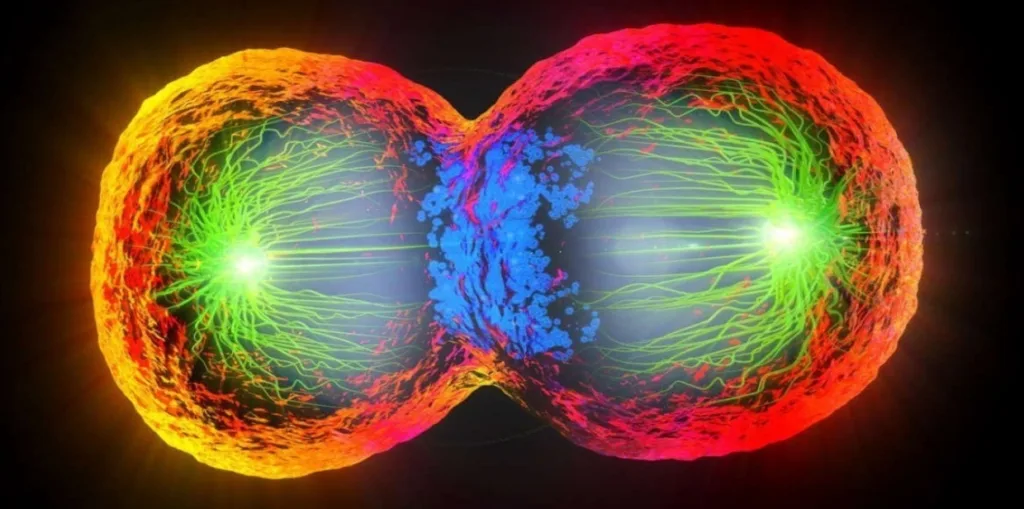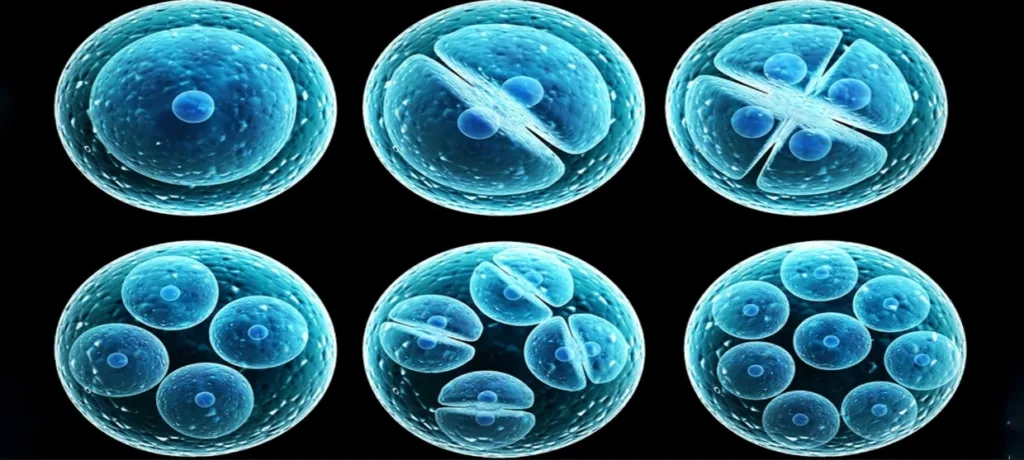CELL CYCLE &CELL DIVISION

1. Cell division Very important process in all living organisms –> to maintain continuity of life
2. During the division of a cell —> DNA replication and cell growth take place.
3. Cell division, DNA replication, and Cell growth–> Take place in a coordinated way to ensure correct division and formation of progeny cells containing intact genomes.
4. Cell cycle –> The sequence of events by which a cell duplicates its genome, synthesises the other constituents of the cell and eventually divides into two daughter cells.
5. Cell growth (in terms of cytoplasmic increase) is a continuous process


6. Cell division requirement –> The replicated chromosomes (DNA) are then distributed to daughter nuclei by a complex series of events. These events are under genetic control. (Cyclins & CDK kinase)
7. A typical eukaryotic cell cycle (Human cells) in culture–> Divide once in every 24 hours (23 Hours Interphase + 1 Hour M Phase)
8. Duration of cell cycle
Vary from organism to organism and also from cell type to cell type.
9. Yeast cell cycle in only about 90 minutes.
10. The cell cycle is divided into two basic phases:
●Interphase
●M Phase (Mitosis phase)
11. The M Phase –->Actual cell division or mitosis occurs

12. Interphase –>
• Represents the phase between two successive M phases.
• 95% of the duration of cell cycle.
• It is the resting phase –> during which the cell is preparing for division
• Cell growth and DNA replication takes place in orderly manner.
• Three phases –> G1 Phase + S Phase + G2 Phase = Interphase
• G1 – Means Gap 1; S – Means Synthesis; G2 – Means Gap 2
13. The M Phase
Starts with the nuclear division (karyokinesis) Ends with division of cytoplasm (cytokinesis).
14. G1 phase
Interval between mitosis and initiation of DNA replication (S phase) Cell is metabolically active and continuously grows @ Protein & RNA Synthesis extensively
15. S or synthesis phase
DNA synthesis or replication takes place. Amount of DNA per cell doubles.
2C DNA becomes –> 4C.
(But chromosome number remain same) Each chromosome have double amount of DNA; 2n Cell of G1 phase is Still 2n is S phase
DNA replication begins in the nucleus
Centriole duplicates in the cytoplasm. (In animal cell)


16. G2 phase
Proteins are synthesised;
Preparation for mitosis (cell growth) continues. @ ATP storage takes place & Spindle fibre synthesized
17. G0 Phase
The cells that do not divide further exit G1 phase to enter an inactive stage called quiescent stage (G0 ) of the cell cycle.
Cells in this stage remain metabolically active Not proliferate unless required Considered Paused or suspended in Cell cycle. (NEET 2019 NTA Answer)

18. In animals, mitotic cell division is only seen in the diploid somatic cells.
19. In plants mitotic divisions seen in both haploid and diploid cells.


21. Equational division
Number of chromosomes in the parent and progeny cells is the same @ It’s MITOSIS
22. Mitosis divided into four stages of nuclear division, it is very essential to understand that cell division is a progressive process and very clear-cut lines cannot be drawn between various stages.
23. Mitosis is divided into the following four stages:
1 Prophase
2 Metaphase
3 Anaphase
4 Telophase



24. Prophase –>First stage of mitosis
Initiation of condensation of chromosomal material.
The centriole begins to move towards opposite poles of the cell. The completion of prophase marked by the following events: Chromosomal material –> Compact mitotic chromosomes.
Chromosomes –> Two chromatids attached at the centromere. Initiation of the assembly of mitotic spindle @ the microtubules
In Late prophase –>Golgi body, ER, nucleolus and the nuclear envelope disappears


25. Metaphase
Begins when nuclear membrane completely disappeared Chromosomes are spread through the cytoplasm of the cell.
Conden sation of chromosomes is completed
@ Maximum condensation ; Visible under microscope Morphology of chromosomes is most easily studied.
Metaphase chromosome –-> two sister chromatids & a centromere.
Small disc-shaped structures at the surface of the centromeres are called kinetochores. Sites of attachment of spindle fibres @ Protein Plates
Metaphase is characterised by all the chromosomes coming to lie at the equator with one chromatid of each chromosome connected by its kinetochore to spindle fibres from one pole and its sister chromatid connected by its kinetochore to spindle fibres from the opposite pole Metaphase plate –> The plane of alignment of the chromosomes at metaphase
The key features of metaphase are:
●Spindle fibres attach to kinetochores of chromosomes. ;
●Chromosomes are moved to spindle equator and get aligned along metaphase plate through spindle fibres to both poles.
26. Anaphase

At the onset of anaphase
o Splitting of chromosome @ Splitting of Centromere
o Two daughter chromatids, now referred to as chromosomes of the future daughter nuclei,
o Daughter chromatid / New chromosome begin their migration towards the two opposite poles.
o As each chromosome moves away from the equatorial plate
27. Telophase
Final stage of mitosis
At the beginning of telophase
o The chromosomes that have reached their respective poles
o They de-condense and lose their individuality.
The individual chromosomes can no longer be seen and chromatin material tends to collect in a mass in the two poles
Nuclear envelope assembles around the chromosome clusters.
Nucleolus, golgi complex and ER reform.
28. Cytokinesis –> Division of cytoplasm after karyokinesis
●In an animal cell –> Cell furrow method
(The furrow gradually deepens and ultimately joins in the centre dividing the cell cytoplasm into two)
●In a plant cells –> Cell plate method

29. IN PLANT CELLS
Cell wall formation starts in the centre of the cell and grows outward to meet the existing lateral walls.
The formation of the new cell wall begins with the formation of a simple precursor, called the cell-plate that represents the middle lamella between the walls of two adjacent cells.
Golgi apparatus plays important role in cell wall formation by secreating wall materials. Phragmoplast is precursor of cell plate
30. In some organisms
karyokinesis is not followed by cytokinesis as a result of which multinucleate condition arises leading to the formation of syncytium
(e.g., liquid endosperm in coconut).
31. Significance of Mitosis –>
Mitosis or the equational division is usually restricted to the diploid cells only.
However, in some lower plants and in some social insects haploid cells also divide by mitosis. Mitosis usually results in the production of diploid daughter cells with identical genetic complement.
MAIN DIVISION OF GROWTH
Reason of mitosis –>
Cell growth results in disturbing the ratio between the nucleus and the cytoplasm. It therefore becomes essential for the cell to divide to restore the nucleo-cytoplasmic ratio. A very significant contribution of mitosis is cell repair.
Mitotic divisions in the meristematic tissues
Specialised kind of cell division that reduces the chromosome number by half results in the production of haploid daughter cells.
Meiosis ensures the production of haploid phase in the life cycle of sexually reproducing organisms whereas fertilisation restores the diploid phase.
Takes place during sporogenesis & gametogenesis respectively in plants and animals. This leads to the formation of haploid spores and gametes.
In Plants -> SPORIC MEIOSIS
In Animals ->GAMETIC MEIOSIS
In Lower Plants ->ZYGOTIC MEIOSIS
33. The key features of meiosis
Meiosis involves two sequential cycles of nuclear and cell division called meiosis I and meiosis II but only a single cycle of DNA replication.
Meiosis I is initiated after the parental chromosomes have replicated to produce identical sister chromatids at the S phase. l Four haploid cells are formed at the end of meiosis II.


34. MEIOSIS
Prophase I –> Longest phase of meiosis ,Anaphase II –> Shortest Phase of meiosis
35. PROPHASE I
Subdivided into the following five phases based on chromosomal behaviour, i.e., Leptotene, Zygotene, Pachytene, Diplotene and Diakinesis.

36. Leptotene
compaction of chromosomes continues
37. Zygotene
Chromosomes start pairing together and this process of association is called synapsis. Such paired chromosomes are called homologous chromosomes.
Synaptonemal complex —> a pair of synapsed homologous chromosomes is called a bivalent or a tetrad.


38. Pachytene
Bivalent chromosomes now clearly appears as tetrads. @ 4 strand stage
This stage is characterised by the appearance of RECOMBINATION NODULES, the sites at which crossing over occurs between non-sister chromatids of the homologous chromosomes.
39. Crossing over is the exchange of genetic material between two homologous chromosomes.
40. Crossing over is also an enzyme-mediated process and the enzyme involved is called recombinase.
41. Crossing over leads to recombination of genetic material on the two chromosomes.
42. Recombination between homologous chromosomes is completed by the end of pachytene, leaving the chromosomes linked at the sites of crossing over.
43. Diplotene
The dissolution of the synaptonemal complex The tendency of the recombined homologous chromosomes of the bivalents to separate from each other except at the sites of crossovers. These X-shaped structures, are called chiasmata.
In oocytes of some vertebrates, diplotene can last for months or years.
44. Diakinesis
The final stage of meiotic prophase I is DIAKINESIS. This is marked by terminalisation of chiasmata.
During this phase the chromosomes are fully condensed and the meiotic spindle is assembled to prepare the homologous chromosomes for separation.
By the end of diakinesis, the nucleolus disappears and the nuclear envelope also breaks down. Diakinesis represents transition to metaphase.
45. Metaphase I:
The bivalent chromosomes align on the equatorial plate
The microtubules from the opposite poles of the spindle attach to the pair of homologous chromosomes.
46. Anaphase I:
The homologous chromosomes separate, while sister chromatids remain associated at their centromeres
@ No splitting of centromere
47. Telophase I:
The nuclear membrane and nucleolus reappear, cytokinesis follows and this is called as DYAD OF CELLS
48. INTERKINESIS
The stage between the two meiotic divisions is called and is generally short lived. S Phase absent; G1 + G2 Phase Only
Interkinesis is followed by prophase II, a much simpler prophase than prophase I.
49. Meiosis II
Meiosis II resembles a normal mitosis.
Divided into Prophase II, Metaphase II, Anaphase II & Telophase II
50. Prophase II:
The nuclear membrane disappears by the end of prophase II The chromosomes again become compact.
51. Metaphase II:
Chromosomes align at the equator and the microtubules from opposite poles of the spindle get attached to the kinetochores of sister chromatids.
52. ANAPHASE II:
It begins with the simultaneous splitting of the centromere of each chromosome allowing them to move toward opposite poles of the cell
53. Telophase II:
Meiosis ends with telophase II, in which the two groups of chromosomes once again get enclosed by a nuclear envelope; cytokinesis follows resulting in the formation of tetrad of cells i.e., four haploid daughter cells
54. Meiosis is the mechanism by which conservation of specific chromosome number of each species is achieved across generations
55. Meiosis increases the genetic variability in the population of organisms from one generation to the next. Variations are very important for the process of evolution.
Copyright © All right reserved



Pingback: Basic unit of Life - sciencegajab
Pingback: CANCER: NON-INFECTIOUS DISEASE: - sciencegajab